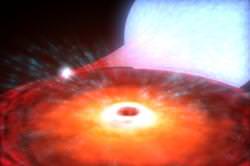Black holes seem to have no upper limit; some weigh in at hundreds of millions of times the mass of the Sun. But how small can they be? Astronomers have discovered what they think is the least massive black hole ever seen, with a mere 3.8 times the mass of the Sun, and a diameter of only 25 km (15 miles) across.
The announcement was made by Nikolai Shaposhnikov of NASA’s Goddard Space Flight Center and his colleagues at the American Astronomical Society High-Energy Astrophysics Division currently being held in Los Angeles, California.
The “tiny” black hole, known as XTE J1650-500, was discovered back in 2001 in a binary system with a normal star. Astronomers had known about the binary system for several years, but they were finally able to make accurate measurements using NASA’s Rossi X-ray Timing Explorer (RXTE) to pin down the mass.
Although black holes themselves are invisible, they’re often surrounded by a disk of hot gas and dust – material chokes up, like water going down the drain. As the hot gas builds up, it releases torrents of X-rays at regular intervals.
Astronomers have long suspected that the frequency of these X-ray blasts depend on the mass of the stars. As the mass of the black hole increases, the size of the accretion disk expands outward too; there are less frequent X-ray emissions.
By cross referencing this method with other, established techniques for weighing black holes, the team is very confident that they’ve got the trick to measuring black hole mass.
When they applied their technique to XTE J1650-500, they turned up a mass of 3.8 Suns, give or take half a solar mass. This is dramatically smaller than the previous record holder at 6.3 Suns.
What’s the smallest possible black hole? Astronomers think it’s somewhere between 1.7 and 2.7 solar masses. Smaller than that and you get a neutron star. Finding black holes that approach this lower limit will help physicists better understand how matter behaves when its crushed down in this extreme environment.
Original Source: NASA News Release


That is amazing. I Never knew that a black hole of this mass could be found. I still wonder though how much of a pull would a smaller mass formation like this have on a planet that is much greater then it’s own size and even greater then it’s own mass?? Is there any way to even begin calculating this and would this effect the mass of the black hole in any way??
Even Super Jovian Class planets are smalled than 1 solar mass. It would be impossible to get a planet as large at 3.8 solar masses.
# Jacob Gregory Says:
April 1st, 2008 at 2:39 pm
“I still wonder though how much of a pull would a smaller mass formation like this have on a planet that is much greater then it’s own size and even greater then it’s own mass??”
# Jordan Lapp Says:
April 1st, 2008 at 3:35 pm
“Even Super Jovian Class planets are smalled than 1 solar mass. It would be impossible to get a planet as large at 3.8 solar masses.”
Exactly. Anything more massive than about 80 times the mass of Jupiter (very roughly 1/12 solar masses) will be able to sustain nuclear fusion in it’s core and become a Red Dwarf star. So a planet, in the sense that we define them, could not become ‘greater’ than the size of this newly discovered black hole.
However, we could imagine this black hole in orbit around our Sun or another star, in which case there would definitely be a significant gravitational effect. In fact, at 3.8 Ms, it would whip our Sun quite significantly, and depending on the separation of the two objects, may accrete matter from it too… It all depends on the relative mass and separation of the black hole and any object it is near.
“Is there any way to even begin calculating this and would this effect the mass of the black hole in any way??”
There are well defined equations that we can use in such circumstances to calculate such things as the orbital parameters of the system and the particulars of the accretion of mass by the black hole, and the list goes on…
Chandra limit of 1.4 solar mass begets white dwarf.1.4 to 3 begets neutron stars .More than 3 solar mass begets black hole.They have experimetally found the lower limit.Congrats.
Over time Hawking Radiation will reduce the mass of a black hole. How little mass can a black hole be before it evaporates completely.
From the ancestral time the world space research established on blind theory. We although demand that we have discovered lots of mysteries viz. milk ways, galaxies, nebulas, white drafts, black holes etcs., in real they are creation of space mirror. SPACE MIRROR is the truth and hidden mystery of the space. Since we are unknown about space mirror, our research has diverted from original truth and we have spent lots of time and money behind the false truth.
In short it can not be explain. Therefore it invites to visit http://www.spacemirrormystery.com to know the great truth.